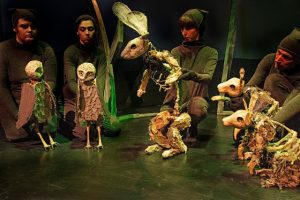
Concrete Temple Theater is a multi-disciplinary company committed to creating compelling new theatrical works. Begun in 2004, they incorporate drama, dance, puppetry, music and visual arts. In their mission statement, they focus on presenting works that address real issues within communities such as grief, family relationships and environmental stewardship. Packrat falls into the latter category.
Bud is the title character and he, like all of this cast, are puppets of various styles. He is a packrat. Bud collects human “treasures” found on the desert floor. Humans know them better as litter or forgotten items casually tossed aside. A silver spoon and an opened bag of marshmallows play important roles in the story.
A faceless cowboy exuberantly drives through these creatures’ homeland in his car. This puppet is very amusing. He is built larger than life as would be the size view from an animal’s perspective. He dons an enormous cowboy hat and a lit cigar. An ash falls into the dry grasses and sets the land ablaze. Puppet animals start to scatter amidst the devastation.
Judgmental squirrels believe Bud’s hoarding of human treasures is the cause of the fire. Such activity is illegal, they remind. The humans are obviously mad. The squirrels want Bud banned. Their leader is a jack rabbit named Firestone who is Bud’s friend. He sleeps to think of a solution. One is revealed through a dream.
Firestone tells Bud that he needs to search for Artemisia, a land of big sagebrush. This is the place where there will be no humans. It must be found for the benefit of all. Bud attempts to take all of his belongings on this journey but there are too many trinkets to carry. He has to narrow it down to the most important treasure. Oh, the choices! The relocation adventure begins.
Renee Philippi is the writer and director of Packrat. The story is a simple one exposing the harm caused by humans unconcerned and unconnected with their impact on the environment. This tale is obviously a microcosm of larger issues concerning environmental damage and blatant disregard for nature. The focus here on the act of one person’s carelessness stresses the point of each and everyone’s responsibility to the land and its inhabitants.
The story of Packrat is simple and sweet. Three of us attended this production together and we all found some moments oddly confusing. Determining which rat puppet was the main character was not always crystal clear.
The puppets themselves are an interesting visual blend of styles. Carlo Adinolfi designed the puppetry, projections and set. Some animals appear as suggested forms with exposed rib cages. When burrowing owls run across the floor, their feet rapidly tap on the floor. The moment is delightful and just makes you smile. Another style uses outlines to suggest dreamlike forms and reminded me of dried palm fronds.
The set is composed of curved sculptures which function as blades of grass. They are moved around as location changes require. The puppeteers are visible but clad in black clothing. They add vocals to the soothing voice over narration by Vera Beren.
Packrat is an enjoyable little tale probably best suited to children given the simplistic themes and good-natured vibe. The creative elements, however, do provide some whimsical moments that will appeal to anyone who admires artistic inventiveness.
Packrat will be performed at Dixon Place through February 15th. The show is traveling to the Flint Repertory Theater in Michigan for the weekend of February 21 – 23, 2020.
